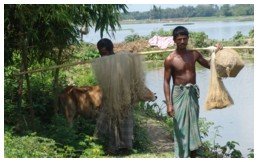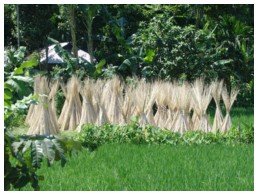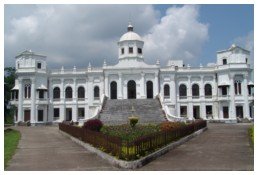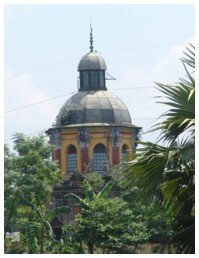|
 To
arrive in Kurigram from
Dhaka, you have to cross the wide Jamuna
river, the same river that is known under the name Brahmaputra, and later
you also cross the river Tisla, to turn back to the Jamuna river, on the
borders of which the capital (sadar) of Kurigram can be found. Kurigram is
known as one of the poorest districts of
Bangladesh, A large part of the area consists of water, even
more so when the wet season and flooding have arrived. To the east the
char area's can be found, the riverine islands and sand bars in the
enormous river. However temporary those place may be, the poorest people
live on them, they are called char dwellers. Their house and land are
disappearing with the seasons, the land re-emerges elsewhere, the house is
lost forever. To
arrive in Kurigram from
Dhaka, you have to cross the wide Jamuna
river, the same river that is known under the name Brahmaputra, and later
you also cross the river Tisla, to turn back to the Jamuna river, on the
borders of which the capital (sadar) of Kurigram can be found. Kurigram is
known as one of the poorest districts of
Bangladesh, A large part of the area consists of water, even
more so when the wet season and flooding have arrived. To the east the
char area's can be found, the riverine islands and sand bars in the
enormous river. However temporary those place may be, the poorest people
live on them, they are called char dwellers. Their house and land are
disappearing with the seasons, the land re-emerges elsewhere, the house is
lost forever. |
|
 The
district is poor but also beautiful and buzzing with activity. There are
hardly any cars or machines, everything is done by hand. Driving over the
s The
district is poor but also beautiful and buzzing with activity. There are
hardly any cars or machines, everything is done by hand. Driving over the
s mall
village roads, you see lots of agricultural activity. Cows, goats, chickens and even pigs are
walking freely around or are herded; people are working in the rice fields
or catching fish. Sometimes women on the side of the roads are making
mats. Jute is harvested; the leaves are used to make different kinds of
articles, for instance carpets, which are sold in the richer Dhaka. The
jute sticks are dried in the sun and used as fuel. mall
village roads, you see lots of agricultural activity. Cows, goats, chickens and even pigs are
walking freely around or are herded; people are working in the rice fields
or catching fish. Sometimes women on the side of the roads are making
mats. Jute is harvested; the leaves are used to make different kinds of
articles, for instance carpets, which are sold in the richer Dhaka. The
jute sticks are dried in the sun and used as fuel.
There is so much water, that sometimes you have to wade through the water
to get to a hut, or use the boat to cross the sudden lake. People live
everywhere, every small patch of land is occupied. When you live in the
country with the highest population density of the world, you have to use
every available square centimeter of land. |
|
 In
Kurigram, there are no remnants of older times. Maybe the area was not
inhabitable before, because of all the water, and even if it was, the
water may have destroyed everything that was left by now. In Rangpur,
however, a district on the way between Dhaka and Kurigram, there are
traces left of history. One of them is Tajhat Palace, a beautiful enormous
rajbari. In the 1990s it was used by the Bangladesh' High Court, but now
it is deserted. Inside, you can find some hi In
Kurigram, there are no remnants of older times. Maybe the area was not
inhabitable before, because of all the water, and even if it was, the
water may have destroyed everything that was left by now. In Rangpur,
however, a district on the way between Dhaka and Kurigram, there are
traces left of history. One of them is Tajhat Palace, a beautiful enormous
rajbari. In the 1990s it was used by the Bangladesh' High Court, but now
it is deserted. Inside, you can find some hi storical
and Hindu artifacts, but the place is devoid of tourists or government
staff members. In the mid 19th century the place was built by Manna Lal
Ray, a rich Hindu jeweler,
who also got the title of raj. It is so empty inside, that you can use
your own imagination and fill the huge rooms with well dressed dancing
guests, probably wearing the exquisite jewelry, designed by their host. storical
and Hindu artifacts, but the place is devoid of tourists or government
staff members. In the mid 19th century the place was built by Manna Lal
Ray, a rich Hindu jeweler,
who also got the title of raj. It is so empty inside, that you can use
your own imagination and fill the huge rooms with well dressed dancing
guests, probably wearing the exquisite jewelry, designed by their host.
Another beautiful building is the Kali temple. Eight Hindu goddesses are
hanging on the outside, and since they are naked from the waist upwards,
it is a miracle they have not been damaged. Most probably this is the case
because hardly any of the inhabitants of Rangpur knows the place exists. I
was greeted by a toothless man, who guarded the temple and was obviously
happy at last somebody had come to visit his goddess Kali. The place
looked completely deserted but everything was, even though dirty, in good
shape. |